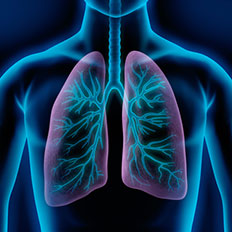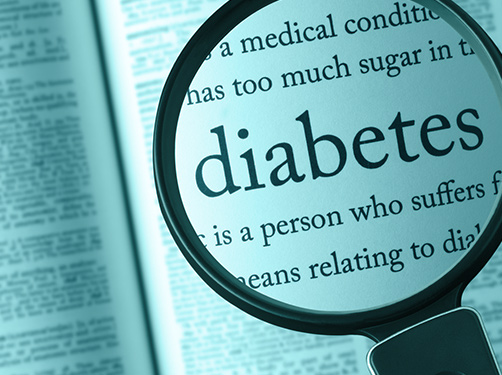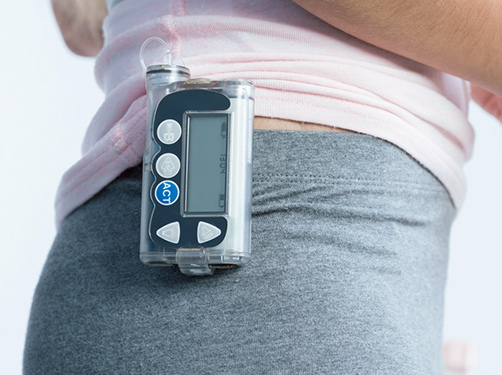Lung diseases associated with diabetes
Scientific support: Prof. Dr. Julia Szendrödi
The lungs are one of the most important organs in the human body. New findings have shown that there is a link between diabetes and various types of lung diseases.
Both type 1 and type 2 diabetes can influence the onset, severity, and progression of lung diseases.

Respiratory symptoms are more commonly observed in people with diabetes than in people of the same age without diabetes. There has been discussion in specialist circles for many years about the relationship between diabetes and impaired lung function. A correlation between diabetes and the following lung diseases has been confirmed or is suspected:
- Asthma
- COPD (chronic obstructive pulmonary disease)
- Pulmonary fibrosis (scarring of the lungs)
- Dyspnea
- Lung cancer
Good to know:
The lung information service at Helmholtz Munich (Link in German) provides comprehensive, up-to-date and unbiased information on lung diseases.
How is diabetes connected to lung diseases?
Little is known about the causes behind the interrelationship between diabetes and lung diseases. Scientists have been discussing several potential reasons for the influence of diabetes on the respiratory tract, lung tissue, and pulmonary vessels.
- Diabetes is accompanied by ongoing underlying inflammation in the body. This can also affect the lungs.
- People with diabetes experience increased oxidative stress, which can cause complex disorders affecting the lung tissue.
- High blood sugar levels promote the growth and proliferation of cancer cells in the lungs.
- Long-term diabetes can damage the blood vessels in the body. This also applies to the pulmonary vessels.
What should people with diabetes pay attention to in relation to the lungs?
People with diabetes and their treating physicians should pay attention to any changes in the lungs.
Frequent dyspnea at low levels of exertion can be the first sign of the long-term effects of diabetes on the lungs – especially in cases with preexisting kidney disease. If breathing problems persist, the lungs should be examined.
It is essential to avoid smoking. Diabetes and smoking are a dangerous combination that can severely and permanently damage almost all the body's organs.
The following is a list of things people with diabetes can do for their pulmonary health:
- Stop smoking
- Ensure good blood sugar levels
- Reduce excess weight
- Get vaccinated against influenza and pneumococci
- Get enough physical activity
The lung information service at Helmholtz Munich (Link in German) provides more information about overcoming tobacco addiction and quitting smoking.
Bronchial asthma is a permanent (=chronic) inflammatory disease affecting the respiratory tract. The disease causes the bronchial system to react with hyperresponsiveness to various types of stimuli.
Asthma is characterized by sudden attacks. When exposed to the relevant stimuli, the bronchi contract and narrow the respiratory tract. This results in, for example, wheezing, shortness of breath, respiratory distress, a feeling of tightness in the chest, or just coughing.
People with diabetes have a higher risk of developing asthma. When compared to people without diabetes, they are twice as likely to suffer from asthma. The risk of asthma is especially high if those with diabetes also smoke.
Diabetes can make preexisting asthma worse. Asthma attacks then become more common and more severe.
Good to know:
The bronchial system is an extensive system of tubes that carries the air we breathe from the windpipe to the small pulmonary alveoli. Here, oxygen is transferred to the blood and carbon dioxide is absorbed from the blood and removed (exhaled) via the bronchial system.
Conversely, asthma can also affect diabetes. The inflammatory substances produced by the body as a result of asthma can have a negative effect on the blood sugar levels in people with diabetes.
Chronic obstructive pulmonary disease (COPD) causes permanent narrowing of the respiratory tract. The most significant risk factor is smoking. COPD is currently the fourth most common cause of death worldwide.
The narrowing of the respiratory tract associated with COPD is caused by persistent inflammatory processes. These processes cause changes, some of which cannot be reversed. There are the typical characteristics of COPD:
- The mucous membrane in the bronchial tubes becomes swollen.
- Some cells in the bronchial walls produce increased amounts of mucus.
- The self-cleaning function of the respiratory tract is impaired and the bronchi cannot be adequately cleared of mucus.
- The bronchial walls become scarred, causing additional narrowing of the respiratory tract.
- The pulmonary alveoli become damaged, making the exchange of breathing gases (oxygen and carbon dioxide) more difficult.
There is a higher incidence of COPD in people with diabetes than in the average population. In particular, people with advanced COPD often also have diabetes.
This observation corresponds to the knowledge that there is an intersection in the disease characteristics between diabetes and COPD. For example, both diseases are accompanied by ongoing underlying inflammation processes in the body. Experts suspect that the inflammatory processes associated with COPD contribute to the development or worsening of diabetes.
It has not yet been definitively determined whether diabetes also increases the risk of COPD.
Permanent inflammation of the lung tissue can lead to pulmonary fibrosis. The inflammatory processes damage organ tissue and replace it with non-functional scar tissue. These are the possible consequences:
- Increased hardened and scarred tissue forms between the pulmonary alveoli and the surrounding blood vessels. This impairs the exchange of breathing gases. The absorption of oxygen into the blood is then limited.
- As the amount of scar tissue increases, the lungs lose elasticity and become stiff. The lungs can then no longer expand properly. Breathing becomes difficult as more strength is needed to breath in.
People with diabetes have a higher risk of developing pulmonary fibrosis. Research has shown that people with kidney disease in particular often develop pulmonary fibrosis as a long-term consequence of diabetes.
Find out more about kidney disease associated with diabetes here!
Conversely, many people with pulmonary fibrosis also have diabetes.
Pulmonary hypertension is also known as high lung pressure. This rare disease causes a severe narrowing of the pulmonary blood vessels, resulting in increased blood pressure in the lungs. Blood flow congestion develops and the right cardiac chamber has to work harder to pump the blood into the lungs. Over time, this leads to overburdening of the heart. People with pulmonary hypertension suffer respiratory distress and chest pain at very low levels of exertion.
Long-term diabetes can permanently damage blood vessels in the body, including the pulmonary blood vessels. For this reason, experts suspect a link between pulmonary hypertension and diabetes. Investigations have confirmed that pulmonary hypertension is more common in people with diabetes than in the average population. However, it remains unclear whether pulmonary hypertension is a complication of diabetes or its cause.
Numerous investigations suggest a connection between diabetes and lung cancer. It may be possible that diabetes increases the risk of lung cancer and exacerbates preexisting lung cancer. However, the role of diabetes in lung cancer requires further study.
Scientists assume that permanently elevated blood sugar levels associated with diabetes promote the growth and proliferation of cancer cells. For this reason, good blood sugar level management is essential for people with lung cancer and diabetes.
Sources:
De Santi, F. et al.: Type 2 diabetes is associated with an increased prevalence of respiratory symptoms as compared to the general population. In: BMC Pulm Med, 2017, 17: 101
Ehrlich, S. F. et al.: Patients diagnosed with diabetes are at increased risk for asthma, chronic obstructive pulmonary disease, pulmonary fibrosis, and pneumonia but not lung cancer. In: Diabetes Care, 2010, 33: 55-60
George, C. et al.: Increased risk of respiratory diseases in adults with Type 1 and Type 2 diabetes. In: Diabetes Res Clin Pract, 2018, 142: 46-55
Khateeb, J. et al.: Diabetes and Lung Disease: A Neglected Relationship. In: Rev Diabet Stud, 2019, 15: 1-15
Kopf, S. et al.: Breathlessness and Restrictive Lung Disease: An Important Diabetes-Related Feature in Patients with Type 2 Diabetes. In: Respiration, 2018, 96: 29-40
Lee, J. Y. et al.: Diabetes mellitus as an independent risk factor for lung cancer: a meta-analysis of observational studies. In: Eur J Cancer, 2013, 49: 2411-2423
Lungenärzte im Netz: www.lungenaerzte-im-netz.de (Letzter Abruf: 22.08.2019)
Lungeninformationsdienst: www.lungeninformationsdienst.de (Letzter Abruf: 21.08.2019)
Robert Koch-Institut: Empfehlungen der Ständigen Impfkommission. (Letzter Abruf: 21.08.2019)
Sona, M. F. et al.: Type 1 diabetes mellitus and risk of cancer: a meta-analysis of observational studies. In: Jpn J Clin Oncol, 2018, 48: 426-433
Thomsen, S. F. et al.: Risk of asthma in adult twins with type 2 diabetes and increased body mass index. In: Allergy, 2011, 66: 562-568
Yang, W. S. et al.: Pre-existing type 2 diabetes and risk of lung cancer: a report from two prospective cohort studies of 133 024 Chinese adults in urban Shanghai. In: BMJ Open, 2014, 4: e004875
As of: 31.10.2019





